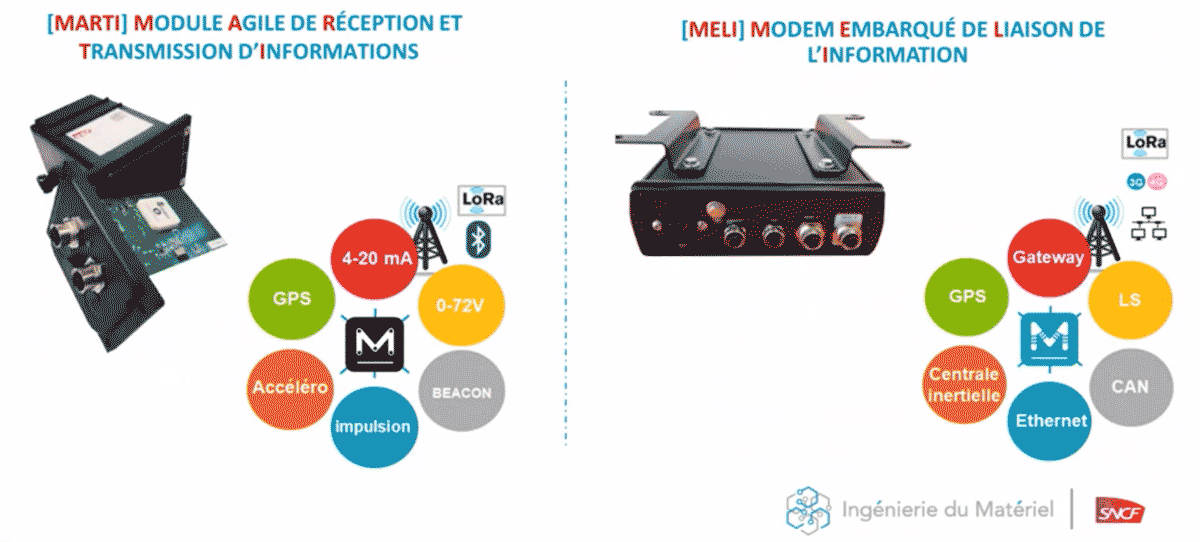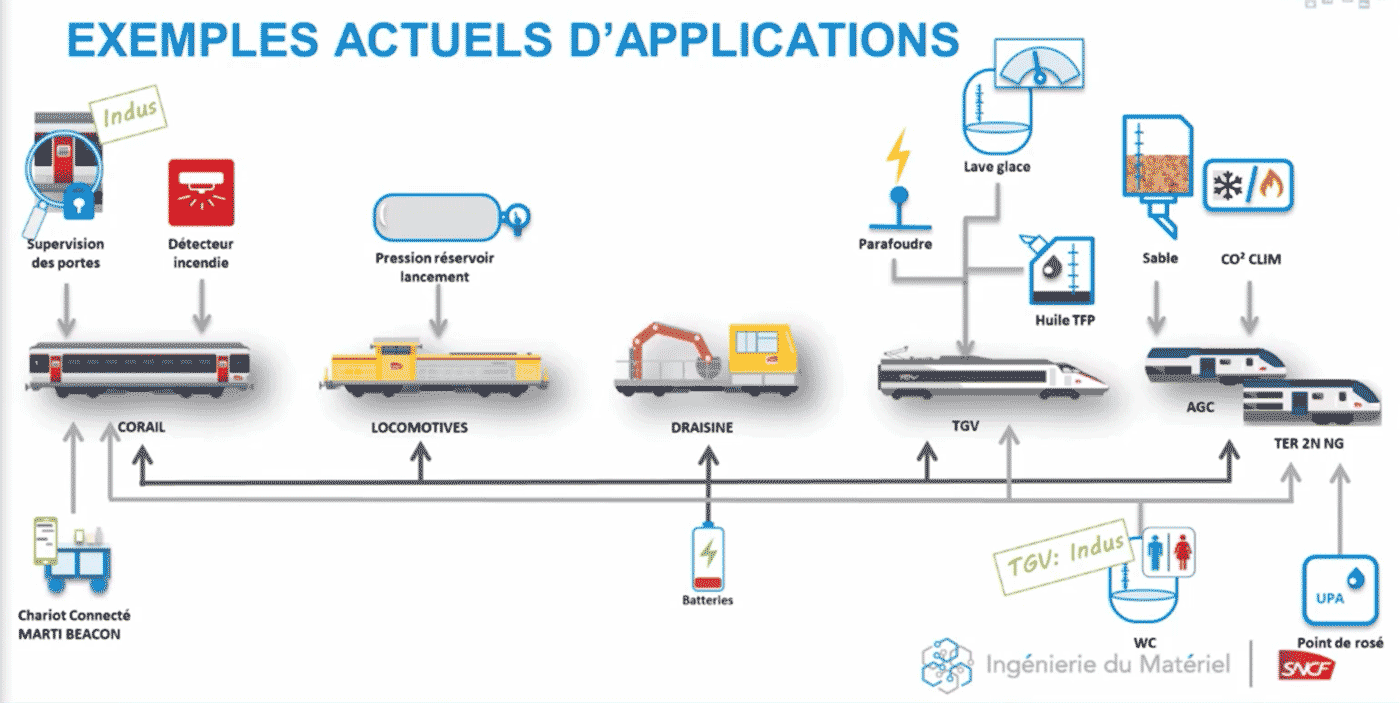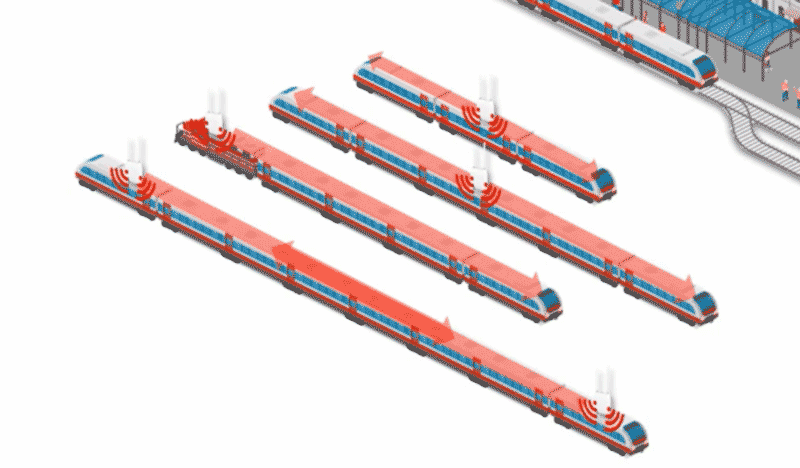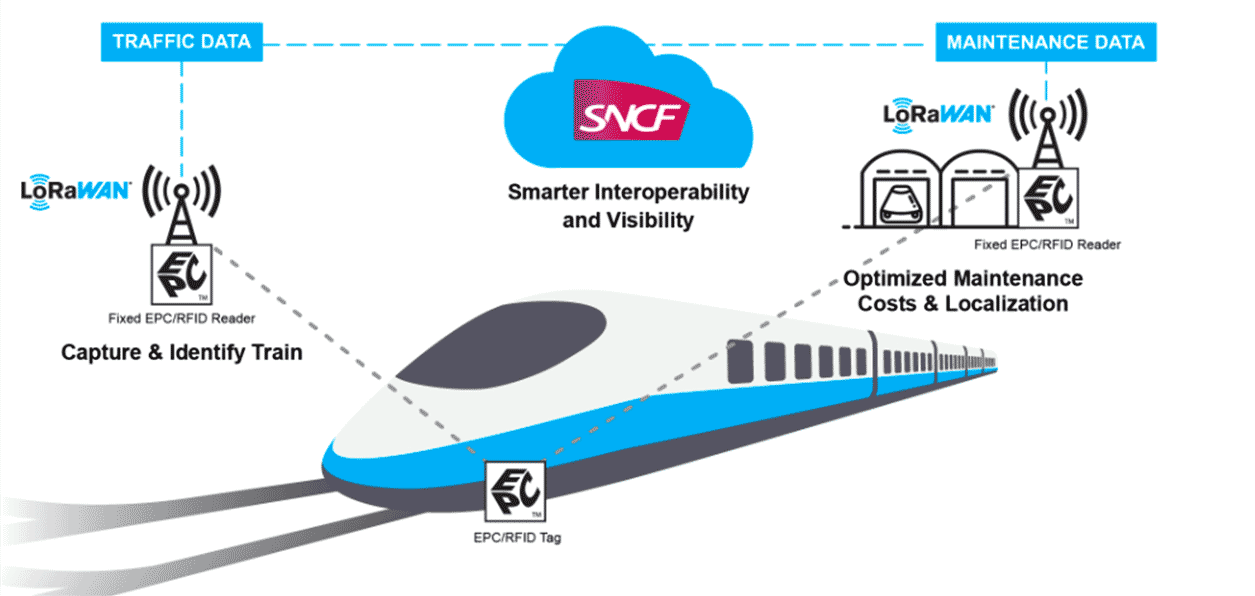


Blog post – Paris, France – Jan 23, 2024
SNCF, the state-owned railway company of France, is extensively implementing IoT solutions for monitoring the inventory and condition of its assets, infrastructure, and rolling stock.
SNCF’s engineering team developed innovative products for an efficient, multi-purpose IoT network using LoRaWAN® technology. This enhances digital transformation, offering cost-effective management and improved security, maintenance, and operations.
LoRaWAN connectivity offers SNCF critical advantages like easy integration and deployment flexibility, enabled by private network infrastructure, provided by Factory Systemes, leading distributor of IT and industrial IoT hardware and software, and powered by Actility’s ThingPark® Enterprise IoT connectivity platform.
Deployment details were presented by Norbert Becuwe, SNCF Ground & On-board Communication Specialist, at the Factory Systemes EDGE#2021 Conference (in French).
SNCF, responsible for nearly all of France’s railway traffic, including the high-speed TGV, operates approximately 14,000 trains daily.
The company faced increasing risks and costs due to outdated, non-connected equipment and infrastructure, highlighting the need for smarter systems. IoT integration in railways focuses on connecting previously isolated systems while safeguarding existing investments. In response to these challenges, SNCF integrated IoT solutions to enhance their diagnostic and maintenance capabilities.
Today, all SNCF locomotives, including TGV and TER, are equipped with IoT devices, facilitating remote sensing and control. The most notable success has been with the 40-year-old ‘Corail’ trains, illustrating SNCF’s commitment to eco-friendly practices by prolonging asset lifespan.
In April 2016, SNCF announced its plans to install sensors across its 50,000 km. of track, 40,000 technical centers, 2,200 referral systems, and all stations. During summer 2017, SNCF installed hundreds of temperature sensors on train rails to prevent accidents, such as the 2014 incident in Brétigny-sur-Marne. Full-scale industrialization began in late 2018 and continues to expand.
SNCF’s R&D team developed two IoT projects, Marti & Meli, to facilitate remote diagnostics and transition maintenance from physical to remote. This shift to preventive and predictive maintenance is crucial for continuous system health monitoring, allowing for timely interventions and failure prevention:
• Marti’ is a versatile module for information transmission, compatible with any sensor and capable of integration into both public and private LoRaWAN networks.
• Meli’, on the other hand, is a specialized LoRaWAN-4G communication gateway, primarily used to transmit data from LoRaWAN sensors via 4G networks to Actility’s LoRaWAN network server.
For efficiency and scalability, SNCF has installed 500 gateways and 6000 MARTI modules in 2021.

Traditional ‘machine-to-machine’ systems required expensive, complex integrations, such as roof antennas and wired sensors, generating large real-time data volumes but with challenging RoI. Conversely, IoT objects with long battery lives (5-10 years) offer simple integration, minimal data generation, and cost-efficiency, thus improving RoI. The wireless sensors allow new use cases, where mainstream solution was still much more expensive and not allowing a good RoI.
Installing equipment on train roofs is complicated due to high voltage catenaries, safety concerns, and the need for certified railway-compliant equipment. Marti & Meli were developed to overcome these challenges.
IoT simplification has been vital for SNCF, reducing tasks that once took days under strict constraints to mere hours, as sensors can be quickly connected, configured, and tested. Before, trains were immobilized for several days, whereas now it only takes half a day to connect all the equipment. The IoT is game-changing from the RoI perspective and the SNCF is benefiting from it.
Mutualizing the Network for a Multitude of Use Cases
SNCF equips all rolling stock series, prioritizing simple measurement IoT applications for practicality and RoI:
• Supervision of opening and closing of train doors to prevent accident, delays and revenue losses due to door malfunctions
• Battery voltage monitoring to reduce risk of failures of storage battery system in trains and therefore reduce their downtime
• Pressure monitoring in the launch tanks to prevent the start of a fire
• Monitoring of the sandpits, windscreen washer tanks and other liquids to reduce train downtimes and expenditures on level controls
• Monitoring of rail tracks temperature to set a dynamic heat-risk management, ensuring the weather or usage does not impact the quality of the rail, and reducing delays and disruption for customers
• Railway container tracking: temperature and location of transferred goods between trains and trucks
• Predictive maintenance planning, product lifecycle tracing and quality assurance: batteries (voltage, internal resistance, health), HVAC modules (air quality, heating/temperature, humidity), monitoring operational efficiency (tachometer data), bearings/wheels (vibration, shock), traction converters/control systems (status, energy consumption), water closets (water level, lighting)
• A TGV trainset today includes 20-50 sensors and each to provide 2,000 pieces of information elements per month. For the new Bombardier trains, it’s 70,000 information elements. Every opening and closing of the doors are tracked, whether at the level of the tension of the belt, the sealing of the joints, etc.
The group also connects the toilets of its TGV trains, to check the filling level of their water tanks. When more than three oars are dry, the train is obliged to stop to be replenished. If smart devices perform these analyzes in real time and warn the train crew, it can be recharged during stops at the station.
With a single network SNCF implements many use cases already and there are many more in the pipeline.

Usually when we think of “infrastructure”, we think of static installations planted on the ground. SNCF has revolutionized the concept of infrastructure by proving that it can be mobile. Their network seamlessly moves with their assets, accommodating the dynamic nature of trains.
After evaluating various connectivity technologies, SNCF now prioritizes LoRaWAN for its adaptability and mobility. Their engineering team has crafted an environment that supports easy reconfiguration to match the ever-changing train compositions.
SNCF needs several gateways that move, and the compositions are very mobile because the train numbers are never the same. And from one day to the next, from one hour to the next, they must replace them and change the composition. The LoRaWAN solution allows for a quick reconfiguration.
In the railway sector, integrating new IT solutions into existing systems is risky and costly. SNCF’s autonomous, train-independent solution, Marti & Meli, simplifies this process, avoiding extensive regression testing and potential disruption to existing systems.
In both trains and automobiles, existing computer systems control crucial functions and often rely on older networks with accessible data. Upgrading these systems with new solutions poses risks and high costs, as each addition requires thorough non-regression testing to avoid disrupting current operations. SNCF’s adoption of an autonomous solution, independent of the train’s primary functions, significantly simplifies this process.
The development of Marti & Meli was a strategic move by SNCF, allowing for a wide range of applications across their entire train fleet. These tools were designed to be versatile and cost-effective, catering to various needs without the need for separate certification processes.
One significant hurdle in railway IoT is the metal structure of trains, which impedes radio wave propagation. SNCF discovered that the effective range of LoRaWAN in trains is more limited, prompting them to install multiple gateways per train to ensure dependable communication.
For trains, the LoRaWAN range is reduced to 200-300 meters, unlike the usual 2km. Considering trains typically consist of 6 to 10 cars, communication reliability diminishes from car to car. Testing revealed that installing 2 to 4 gateways per train, based on the number of cars, enhances communication reliability.

To enhance reliability and performance, SNCF relied on advanced radio management provided by ThingPark Enterprise. and achieved the high success rate necessary for industrialization (99%).
The capability of any LoRaWAN-4G gateway to communicate with any sensor, regardless of train type, simplifies operations. This interoperability is a key advantage, especially considering the impracticality of using embedded network server in each gateway in railway applications.
The establishment of private, mobile IoT networks on a single separate netwok server provides SNCF with numerous benefits: the ability to expand and densify the network, enhance security and reliability, and achieve a high level of availability through multiple gateways. These networks also effectively overcome the propagation challenges posed by the ‘tin can’ nature of trains and offer the advantages of private networks over public ones.
Through continuous research, development, and modernization efforts, SNCF remains at the forefront of IoT technology in the railway industry. Their focus on network reliability and the introduction of innovative IoT solutions helps them lead the market.

© 2024 Actility’s All Rights Reserved